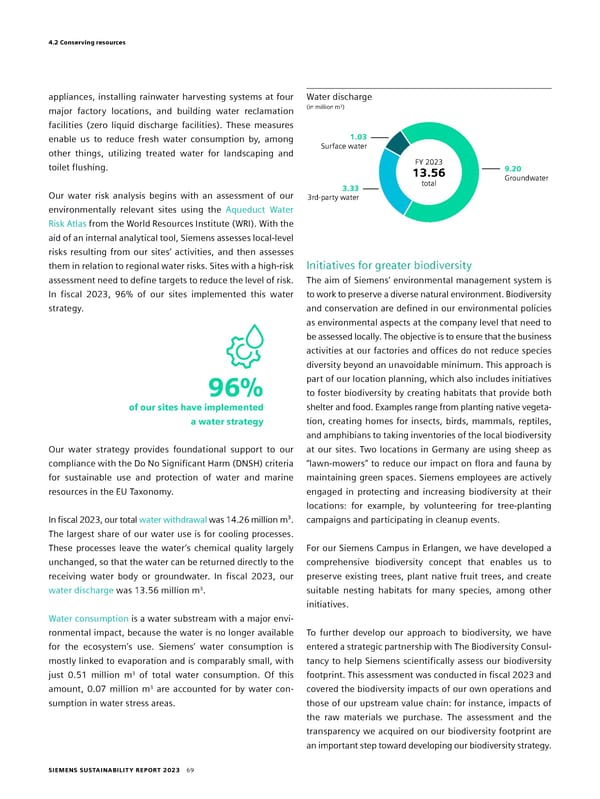4.2 Conserving resources appliances, installing rainwater harvesting systems at four Water discharge 3 major factory locations, and building water reclamation (in million m) facilities (zero liquid discharge facilities). These measures enable us to reduce fresh water consumption by, among 1.03 other things, utilizing treated water for landscaping and Surface water toilet flushing. FY 2023 9.20 13.56 Groundwater 3.33 total Our water risk analysis begins with an assessment of our 3rd-party water environmentally relevant sites using the Aqueduct Water Risk Atlas from the World Resources Institute (WRI). With the aid of an internal analytical tool, Siemens assesses local-level risks resulting from our sites’ activities, and then assesses them in relation to regional water risks. Sites with a high-risk Initiatives for greater biodiversity assessment need to define targets to reduce the level of risk. The aim of Siemens’ environmental management system is In fiscal 2023, 96% of our sites implemented this water to work to preserve a diverse natural environment. Biodiversity strategy. and conservation are defined in our environmental policies as environmental aspects at the company level that need to be assessed locally. The objective is to ensure that the business activities at our factories and offices do not reduce species diversity beyond an unavoidable minimum. This approach is part of our location planning, which also includes initiatives 96% to foster biodiversity by creating habitats that provide both of our sites have implemented shelter and food. Examples range from planting native vegeta- a water strategy tion, creating homes for insects, birds, mammals, reptiles, and amphibians to taking inventories of the local biodiversity Our water strategy provides foundational support to our at our sites. Two locations in Germany are using sheep as compliance with the Do No Significant Harm (DNSH) criteria “lawn-mowers” to reduce our impact on flora and fauna by for sustainable use and protection of water and marine maintaining green spaces. Siemens employees are actively resources in the EU Taxonomy. engaged in protecting and increasing biodiversity at their locations: for example, by volunteering for tree-planting In fiscal 2023, our total water withdrawal was 14.26 million m³. campaigns and participating in cleanup events. The largest share of our water use is for cooling processes. These processes leave the water’s chemical quality largely For our Siemens Campus in Erlangen, we have developed a unchanged, so that the water can be returned directly to the comprehensive biodiversity concept that enables us to receiving water body or groundwater. In fiscal 2023, our preserve existing trees, plant native fruit trees, and create water discharge was 13.56 million m3. suitable nesting habitats for many species, among other initiatives. Water consumption is a water substream with a major envi- ronmental impact, because the water is no longer available To further develop our approach to biodiversity, we have for the ecosystem’s use. Siemens’ water consumption is entered a strategic partnership with The Biodiversity Consul- mostly linked to evaporation and is comparably small, with tancy to help Siemens scientifically assess our biodiversity 3 just 0.51 million m of total water consumption. Of this footprint. This assessment was conducted in fiscal 2023 and 3 are accounted for by water con- amount, 0.07 million m covered the biodiversity impacts of our own operations and sumption in water stress areas. those of our upstream value chain: for instance, impacts of the raw materials we purchase. The assessment and the transparency we acquired on our biodiversity footprint are an important step toward developing our biodiversity strategy. SIEMENS SUSTAINABILITY REPORT 2023 69
 Sustainability Report Page 68 Page 70
Sustainability Report Page 68 Page 70